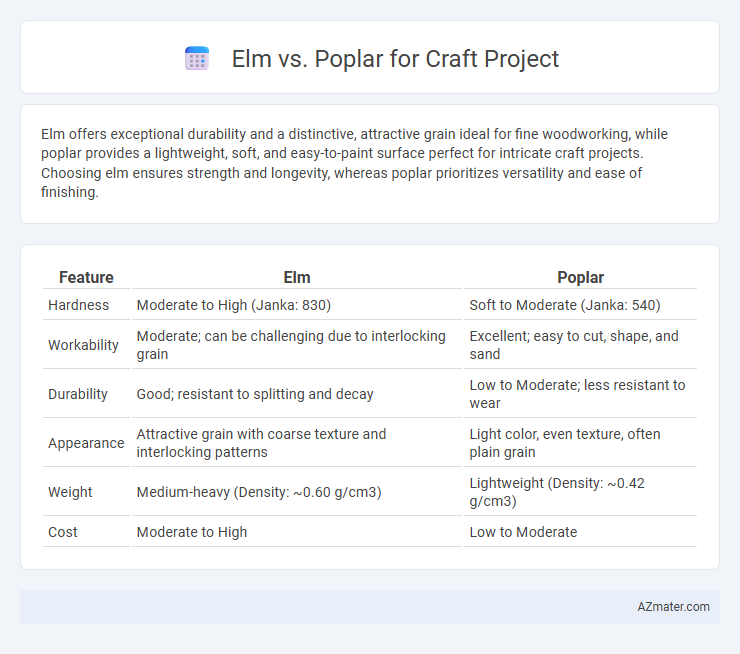Elm offers exceptional durability and a distinctive, attractive grain ideal for fine woodworking, while poplar provides a lightweight, soft, and easy-to-paint surface perfect for intricate craft projects. Choosing elm ensures strength and longevity, whereas poplar prioritizes versatility and ease of finishing.
Table of Comparison
| Feature | Elm | Poplar |
|---|---|---|
| Hardness | Moderate to High (Janka: 830) | Soft to Moderate (Janka: 540) |
| Workability | Moderate; can be challenging due to interlocking grain | Excellent; easy to cut, shape, and sand |
| Durability | Good; resistant to splitting and decay | Low to Moderate; less resistant to wear |
| Appearance | Attractive grain with coarse texture and interlocking patterns | Light color, even texture, often plain grain |
| Weight | Medium-heavy (Density: ~0.60 g/cm3) | Lightweight (Density: ~0.42 g/cm3) |
| Cost | Moderate to High | Low to Moderate |
Introduction to Elm and Poplar Woods
Elm wood, known for its interlocking grain and resistance to splitting, offers excellent durability and a visually appealing grain pattern, making it ideal for furniture and craft projects requiring strength and aesthetic appeal. Poplar wood is lightweight, easy to work with, and features a fine, uniform texture with a pale yellow to greenish hue, often favored for painted crafts and detailed woodworking due to its smooth finish. Both woods provide distinct advantages: elm excels in toughness and natural beauty, while poplar offers ease of machining and versatility in crafting applications.
Physical Properties Comparison
Elm features high density and exceptional strength, making it resistant to splitting and ideal for heavy-duty craft projects, while Poplar is lighter with a fine, even grain that allows for easier cutting and shaping. Elm's natural interlocking grain pattern enhances its toughness and shock resistance, contrasting with Poplar's more uniform texture that provides a smooth finish and better paint adhesion. For applications requiring durability and impact resistance, Elm is preferable; Poplar suits detailed carving or painted results where workability and surface smoothness are priorities.
Workability and Ease of Crafting
Elm wood offers excellent workability due to its interlocking grain, which reduces splintering and makes it ideal for curved or bent wood projects in crafting. Poplar is softer and easier to cut, shape, and sand, making it a popular choice for detailed carving and intricate designs, though it may be less durable for heavy-use items. Both woods provide a smooth finish, but poplar's uniform texture allows for easier paint adhesion, enhancing ease of finishing in craft projects.
Durability and Strength Differences
Elm wood is renowned for its exceptional durability and resistance to splitting, making it ideal for craft projects that require strong, long-lasting materials. Poplar, while easier to work with and lighter, offers moderate strength but lacks elm's robustness in impact resistance and wear. Choosing elm ensures a sturdier finished product suitable for high-stress applications, whereas poplar is preferable for lightweight or decorative crafts.
Grain Patterns and Visual Appeal
Elm features a distinct interlocking grain pattern with prominent rays and flecks, providing a dynamic, rustic appeal ideal for craft projects seeking natural texture and depth. Poplar exhibits a straighter, finer grain with a subtle, uniform appearance, lending itself to smooth finishes and vibrant paint applications for visually clean, versatile crafts. Choosing elm enhances organic, textured aesthetics, while poplar supports sleek, modern designs with consistent coloring and minimal grain distraction.
Suitability for Different Craft Projects
Elm wood boasts a coarse, interlocking grain making it highly durable and resistant to splitting, ideal for furniture and outdoor craft projects that require strength and longevity. Poplar features a softer texture and fine, even grain, lending itself well to detailed carving, painting, and indoor decorative items due to its smooth finish and ease of working. Choosing between elm and poplar depends on project needs, with elm suited for heavy-duty, structural crafts and poplar favored for lightweight, intricate designs.
Finishing and Staining Results
Elm wood displays an attractive open grain pattern that absorbs stains unevenly, often resulting in a rustic, textured finish ideal for traditional craft projects. Poplar, with its fine, tight grain and pale color, accepts paint and stains uniformly, producing a smooth, consistent surface suitable for modern, polished craft items. Understanding these differences helps crafters choose elm for character-rich finishes or poplar for sleek, easily stained results.
Cost and Availability
Elm wood offers a unique balance of durability and aesthetic appeal but tends to be more expensive and less readily available than poplar due to its slower growth and limited supply. Poplar is highly favored in craft projects for its affordability and widespread availability, making it an economical choice for mass production and beginner-friendly woodworking. Comparing cost-effectiveness and accessibility, poplar stands out as the more practical option, while elm suits projects requiring distinctive grain patterns and long-lasting strength.
Environmental Impact and Sustainability
Elm wood, known for its natural resistance to moisture and decay, offers sustainable benefits when sourced from responsibly managed forests, as it supports biodiversity and carbon sequestration. Poplar, a fast-growing hardwood, demonstrates a lower environmental footprint due to its rapid renewability and efficient carbon absorption during growth cycles. Choosing either wood depends on certified sourcing practices, with Elm generally favored for durability and Poplar for eco-friendly, quick regeneration in craft projects.
Choosing the Right Wood for Your Craft
Elm offers exceptional durability and a unique interlocking grain that resists splitting, making it ideal for intricate craft projects requiring strength and detailed carving. Poplar is a lightweight, soft hardwood known for its smooth texture and ease of painting, perfect for projects where a flawless finish and ease of shaping are priorities. Selecting elm or poplar depends on whether durability and natural grain patterns or easy workability and surface finish matter most in your craft project.

Infographic: Elm vs Poplar for Craft Project
 azmater.com
azmater.com